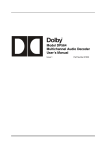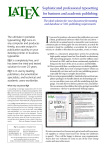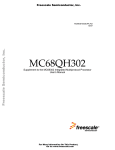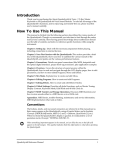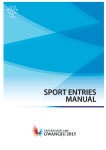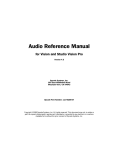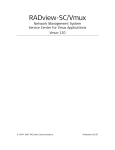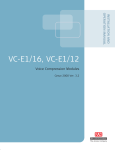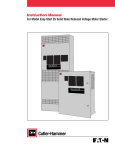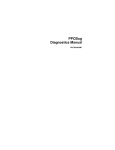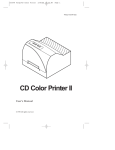Download Signaling System 7 MPC860 SS7 Protocol Microcode User`s Manual
Transcript
MOTOROLA SEMICONDUCTOR TECHNICAL INFORMATION Signaling System 7 MPC860 SS7 Protocol Microcode UserÕs Manual Rev 1.2 July 2, 1997 Signaling System 7 Signaling System 7 1 SS7 Controller Overview 4 2 SS7 Controller Key Features 2.1 SS7 Channel Frame Transmission Processing 2.2 SS7 Channel Frame Reception Processing 2.3 SU filtering 2.3.1 Comparison Mask 2.3.2 Comparison State Machine 4 5 5 6 6 7 3 Microcode Use 3.1 Initialization Procedure 8 8 4 SS7 Memory Map 4.1 SS7-Specific Parameters 4.2 Configuring the General SCC Parameters 4.2.1 GSMR Register 4.2.2 DSR Register 4.2.3 MRBLR Register 8 8 10 10 10 10 5 SS7 Programming Model 5.1 SS7 Command Set 5.1.1 Transmit Commands 5.1.2 Receive Commands 5.2 Octet Counting mode 5.3 Error Monitor Operation 5.3.1 Alignment Error Monitor 5.3.2 Signal Unit Error Monitor 5.3.3 Definition of a good frame 5.3.4 Definition of an errored SU 5.4 SS7 Error Handling Procedure 5.4.1 Transmission Errors 5.4.2 Reception Errors 10 10 11 12 12 13 13 13 14 14 14 14 15 6 Registers 6.1 SS7 Event Register 6.2 SS7 Option Register 6.3 SS7 Mode Register (PSMR) 16 16 17 18 7 SS7 Rx Buffer Descriptor 19 8 SS7 Tx Buffer Descriptor 22 Appendix A - Microcode Initialization Procedure 24 2 Signaling System 7 1 2 3 Initialization Procedure for QUICC Revision $0001 Initialization Procedure for QUICC Revision $0002 Initialization Procedure for QUICC Revision $0003 24 24 25 Appendix B - SS7 Configuration Sequence 26 Appendix C - Performance Estimate 27 3 Signaling System 7 1 SS7 Controller Overview Signaling System #7 (SS7) is a management protocol used in public switching networks. The physical, data link, and network layer functions of the SS7 protocol are called the Message Transfer Part (MTP). The data link layer portion of the MTP (layer 2) is based on HDLC frame formats. However, SS7 at layer 2 also includes some unique functions that are difficult to implement using an unaltered HDLC controller. These functions include: counting the number of octets by which a frame is too long; the continuous sending and receiving of fill in signal units (FISUs) and link status signal units (LSSUs); maintaining the SU Error Monitor; and filtering duplicate back-to-back frames. FISUs are 5 byte frames (three bytes plus 2 CRC bytes) that are sent continuously back-toback when no other data needs to be transmitted. LSSUs are also sent back-to-back during the initial alignment of the protocol. LSSUs are 6 or 7 bytes long. SS7 also differs from other HDLC-based protocols in that the closing flag of one frame can be the opening flag of the next frame. Since these characteristics can make SS7 implementations very demanding, the SS7 controller on the PowerQUICC provides additional help in these areas. The SS7 controller enhances the basic HDLC functionality to include those additional layer 2 functions which are difficult, or time consuming to implement by an external processor. This ss7 Controller microcode for the MPC860 is identical to the ss7 Controller microcode for the MC68360. 2 SS7 Controller Key Features ¥ Uses either NMSI or TDM interface and a variety of data encoding schemes ¥ Flexible data buffers with multiple buffers per signal unit allowed ¥ Separate interrupts for received signal units and transmitted buffers ¥ Maintenance of good frame counter, Alignment Error Rate Monitor, and SU Error Monitor ¥ Standard HDLC features ÑFlag/Abort/Idle generation/detection ÑZero insertion/deletion Ñ16-bit CRC-CCITT generation/checking ÑDetection of non-octet aligned signal units ÑProgrammable number of flags between signal units ¥ Detection of long SUs ¥ Discard short (less than 5 octets) signal units ¥ Automatic Fill-In Signal Unit transmission ¥ Automatic Link Status Signal Unit retransmission and reception ¥ Automatic discard of identical FISUs and LSSUs MOTOROLA 4 Signaling System 7 ¥ Octet Counting Mode support ¥ Command to force a reset of filtering state ¥ Command to force entry into octet counting mode ¥ Ability to permanently disable octet counting mode ¥ Ability to disable FISU and LSSU filtering ¥ Ability to force entry into octet counting mode if a receiver overrun occurs. 2.1 SS7 Channel Frame Transmission Processing The SS7 Controller is designed to work with a minimum amount of intervention from the PowerPC core. It operates in a similar fashion to the HDLC controller on the PowerQUICC, but will automatically transmit a FISU if the current buffer descriptor is not ready. When the core enables one of the transmitters and the first Buffer Descriptor has its ready (R) bit set, the SS7 controller will fetch the data from memory and start transmitting the signal unit (after first transmitting the user-specified minimum number of flags between signal units). When the end of the current BD has been reached, the CRC and the closing flag are appended if the last (L) bit in Tx BD is set. (The TC bit in the Tx BD must be set to transmit the CRC). If the RT bit is clear, the SS7 transmitter writes the signal unit status bits into the BD and clears the Ready bit. If the I bit is set, the TXB event bit will be set in the event register. Thus, the I bit may be used to generate an interrupt after each buffer, after a group of buffers, or after each signal unit (SU) has been transmitted. If the RT bit in the Tx BD is set, the SS7 transmitter will retransmit the buffer descriptor until the RT bit is cleared. The RT bit may be used for LSSU retransmission as well as FISU retransmission (though the controller will automatically send FISUs if the R bit is not set.) The SS7 controller will then proceed to the next Tx BD in the table. If it is not ready, the SS7 controller will transmit FISUs with the first two octets (BSN, BIB, FSN and FIB fields) from the previously transmitted signal unit. The SS7 transmitter samples the first two octets (BSN, BIB, FSN and FIB fields) of every transmitted SU and stores this data in the internal RAM. The SS7 transmitter will transmit FISUs continuously using the sampled two octets until the next SU is ready for transmission. Thus, the user should prepare an SU in the transmit buffer descriptor table before enabling the SS7 transmitter, otherwise the FISU will be transmitted with a random first two octets. If the user wishes to re-arrange the transmit queue before the CP has completed transmission of all buffers, the STOP TRANSMIT command should be issued. This can be useful for transmitting expedited data before previously linked buffers or for error situations. The SS7 controller, when receiving the STOP TRANSMIT command, will stop transmitting and send an ABORT (if it was in the process of transmitting a signal unit) and start transmitting Flags. Alternately, the GRACEFUL STOP TRANSMIT command may be used to stop transmission after the current frame completes. When the SS7 controller is given the RESTART TRANSMIT command, it resumes transmission. MOTOROLA 5 Signaling System 7 2.2 SS7 Channel Frame Reception Processing The SS7 receiver is also designed to work with a minimum amount of intervention from the PowerPC core. The SS7 receiver can perform FISU/LSSU reception (and stripping), CRC checking, maximum signal unit length checking, and minimum signal unit length checking (SUs less than 5 octets). It can also provide interrupts the user on every N unstuffed octets received while in Òoctet countÓ mode. The received signal unit is available to the user for performing any SS7-based protocol. When the core enables one of the receivers, the receiver waits for an opening flag character. When the receiver detects the first byte of the signal unit, the SS7 controller will fetch the next Buffer Descriptor (BD) and, if empty, will start to transfer the incoming signal unit to the BDs associated data buffer. When the data buffer has been filled, the SS7 controller clears the Empty bit in the BD. If the incoming signal unit exceeds the length of the data buffer, the SS7 controller will fetch the next BD in the table and, if empty, will continue to transfer the rest of the signal unit to this BDÕs associated data buffer. During this process the SS7 receiver will store the first five bytes of the SU in the internal RAM. This data will be used to receive identical FISUs/LSSUs only twice. Signal Units that have less than five octets will be discarded without notification to the user. The SS7 receiver will check for a signal unit that is too long by comparing the SU length versus the MFLR register. If the SU is too long, the SS7 receiver enters the ÒOctet CountÓ mode. When the frame ends, the CRC field is checked and written to the data buffer. The length of the entire signal unit is written to the data length field of the last BD. The SS7 controller sets the last (L) bit, writes the signal unit Status bits into the BD, and clears the Empty bit if the CM bit is clear. It then sets the RXSU bit in the event register, indicating that a signal unit has been received and is in memory. The SS7 controller then waits for a new signal unit. The SS7 receiver will close a buffer and generate interrupt only when the first and second FISU/LSSU is received. When the next FISU/LSSU is received and this FISU/LSSU is identical to the two previous FISUs/LSSUs, the FISU/LSSU will be discarded (stripped). 2.3 SU filtering In order to reduce the overhead to the user software, a filtering algorithm has been adopted to allow superfluous frames to be discarded. This algorithm compares the first 3-5 bytes (depending on type) of the current FISU or LSSU to the last SU received and will discard if it has already received that SU twice. 2.3.1 Comparison Mask A user programmable 5-byte mask exists in the parameter RAM map. When an SU is received, the controller checks the contents of the LI field. If the value is between 0 and 2, the SU (except for the CRC portion) will be masked according to the user programmable mask and will then be compared to the last SU received. The state machine for the matching algorithm is in Section 2.3.2. MOTOROLA 6 Signaling System 7 2.3.2 Comparison State Machine The following state machine exists for filtering 0 2 1 ¥ State 0 - The first 3-5 bytes (depending on the contents of the LI field) are masked and then compared with the first 3-5 bytes of the last SU. If there is a match, go to State 1, else remain in State 0. The current SU will be received into a Buffer Descriptor. ¥ State 1 - The first 3-5 bytes (depending on the contents of the LI field) are masked and then compared with the first 3-5 bytes of the last SU. If there is a match, go to State 2, else go to State 0. The current SU will be received into a Buffer Descriptor. ¥ State 2 - The first 3-5 bytes (depending on the contents of the LI field) are masked and then compared with the first 3-5 bytes of the last SU. If there is a match, the current SU will be discarded (unless there is an error) and the channel will remain in state 2. The Error Free SU Counter will be incremented and the ERM will be adjusted accordingly. If the frames do not match, the current SU will be received into a Buffer Descriptor and the channel will return to State 0. 2.3.2.1 Filtering Limitations Since the algorithm is purely checking IDENTICAL SUs, that means that TWO FISUs will be received after each MSU rather than merely one, even though they have the same sequence numbers. MOTOROLA 7 Signaling System 7 3 Microcode Use The Signaling System 7 microcode must be loaded into PowerQUICC RAM at initialization time. It will be a 'large' (1024 byte) microcode and thus will consume the memory area from DPRAM_Base + $000 to DPRAM_Base + $3ff. In addition, the ÒMicrocode ScratchÓ area of the memory map from DPRAM_Base + $600 to DPRAM_Base + $6FF will be unavailable for user program use. (See Section 16.6 of the PowerQUICC User's Manual for more information) 3.1 Initialization Procedure See appendix A for instructions on how to load and initialize the microcode. 4 SS7 Memory Map 4.1 SS7-Specific Parameters When configured to operate in SS7 mode, the PowerQUICC overlays the structure illustrated listed in Table 16-23 of the PowerQUICC UserÕs Manual with the SS7-specific parameters described in Table 4-1. Table 4-1. SS7-Specific Parameters Address SCC Base+34 SCC Base+38 SCC Base+3C SCC Base+3E SCC Base+40 SCC Base+42 SCC Base+44 SCC Base+46 SCC Base+48 SCC Base+4A SCC Base+4C SCC Base+4E SCC Base+50 SCC Base+54 SCC Base+58 SCC Base+5A SCC Base+5c SCC Base+60 SCC Base+61 SCC Base+64 SCC Base+68 SCC Base+6a Name C_MASK C_PRES EFSUC Reserved MFLR Temp ERM N N_cnt T D D_cnt Temp Temp Temp S7_OPT Mask1 Mask2 Reserved Temp Temp Temp Width Long Long Word Word Word Word Word Word Word Word Word Word Long Long Word Word Long Byte 3 Bytes Long Word Word Description CRC Constant CRC Preset Error Free SU Counter Reserved Max Frame (SU) Length Register Temp Error Monitor Counter Interrupt Threshold in Octet Count Mode (N=16) Temporary down counter for N Parameter for ERM Parameter for ERM Parameter for ERM Temp Temp Temp SS7 Configuration Options Mask for FISU Filtering Mask for FISU FIltering Temp Temp Temp Note: Entries in boldface must be initialized by the user C_MASK This value should be initialized with $0000F0B8. MOTOROLA 8 Signaling System 7 C_PRES This value should be initialized with $0000FFFF. EFSUC This 16-bit counters is maintained by the CP. It may be initialized by the user while the channel is disabled. The Error Free SU Counter is incremented whenever an error-free SU is received (even if the frame is discarded by the filtering algorithm). MFLR Maximum Frame Length. This should be set to 278 for the Signaling System 7 protocol. If a frame is received that is longer than MFLR, Octet Counting Mode will be entered. Frame Length does not include the opening and closing flags. ERM This 16 bit counter is used for a leaky-bucket implementation of the SU Error Monitor and the Alignment Error Monitor. It must be initialized to zero. This counter will not be updated while the Error Monitor is disabled (using the bit in the SS7 Option Register). N, N_cnt, D, D_cnt, T The leaky bucket algorithm relies on three parameters. They are as follows: ¥ N, After every N octets are received while in octet counting mode, ERM will be incremented and the OCT bit in the SS7 Event Register will be set. N_cnt must be initialized to the same value as N. N_cnt decrements at all times, whether the link is in octet counting mode or not. ¥ D, After D signal units (good or bad) or N octets in octet counting mode have been received, ERM will be decremented. ERM will not be decremented below zero. The D_cnt parameter must be initialized to the same value as D. This counter is not used when the Error Monitor is in Alignment Error Monitor mode. In addition, it will not be used when the Error Monitor is disabled. ¥ T, If ERM reaches T, the ERM bit in the SS7 Event Register will be set and ERM will be reset to zero. S7_OPT This is the location of the SS7 Option Register. It is described in Section 6.2. Mask1, Mask2 This is the mask to be used for SU filtering. The mask should be in reverse-byte order. Thus the format is: MSBit LSBit Byte 4 Byte 3 Byte 2 Byte 1 Figure 4-1. Mask1 Format MOTOROLA 9 Signaling System 7 MSBit Byte 5 Figure 4-2. Mask2 Format Note This format is reversed from the normal Motorola byte storage method. Also known as ÒLittle EndianÓ. 4.2 Configuring the General SCC Parameters The general SCC parameters can be configured as described in section 16.14 of the PowerQUICC UserÕs Manual except for the following changes: 4.2.1 GSMR Register The General SCC Mode Register bits are the same except for: RTSMÑRTS Mode 0Ñ Do not use. 1Ñ Flags are transmitted between frames rather than idles. RTS is always asserted whenever the SCC is enabled. 4.2.2 DSR Register The SCC Data Synchronization Register should be programmed to $7E7E. 4.2.3 MRBLR Register The Maximum Receive Buffer Length Register, like HDLC, must be evenly divisible by 4. In addition, it must be 8 or larger in order for SU filtering to work properly. 5 SS7 Programming Model The core configures each SCC to operate in one of the protocols by the MODE bits in the GSMR. The SS7 controller uses the same data structure as in the other protocols. This data structure supports multi-buffer operation. The receive errors are reported through the Rx BD. The transmit errors are reported through the Tx BD. An indication about the status of the lines (CD, and CTS) is reported through the port C pins. A maskable interrupt may be generated upon a status change in either one of those lines. 5.1 SS7 Command Set The following commands are issued to the Command Register. MOTOROLA 10 Signaling System 7 5.1.1 Transmit Commands After a hardware or software reset and the enabling of the channel in the SCC mode register, the channel is in the transmit enable mode and starts polling the first BD in the table every 64 transmit clocks, or immediately if the TOD bit in the TODR is set. STOP TRANSMIT Command The STOP TRANSMIT command disables the transmission of frames on the transmit channel. If this command is received by the SS7 controller during frame transmission, transmission is aborted after a maximum of 16 additional bits are transmitted and the transmit FIFO is flushed. The TBPTR is not advanced. No new BD is accessed and no FISUs are transmitted for this channel. The transmitter will transmit an abort sequence consisting of Ò01111111Ó (if the command was given during frame transmission) and then begin to transmit flags. NOTE If the MFF bit in the PSMR is set, then it is possible for one or more small frames to be flushed from the transmit FIFO. To avoid this, the GRACEFUL STOP TRANSMIT command should be used. GRACEFUL STOP TRANSMIT Command The GRACEFUL STOP TRANSMIT command is used to stop transmission in an orderly way, rather than abruptly as performed by the regular STOP TRANSMIT command. It stops transmission after the current frame has completed transmission, or immediately if there is no frame currently being transmitted. The channel will not transmit FISUs. The GRA bit in the SCCE will be set once transmission has stopped. After transmission ceases, the SS7 transmit parameters, including BDs, may be modified. The TBPTR will point to the next Tx BD in the table. Transmission will begin once the Ready bit of the next BD is set and the RESTART TRANSMIT command is issued. RESTART TRANSMIT Command The RESTART TRANSMIT command re-enables the transmission of characters on the transmit channel. This command is expected by the SS7 controller after a STOP TRANSMIT command, after a GRACEFUL STOP TRANSMIT command, or after a transmitter error. The SS7 controller will resume transmission from the current transmitter BD (TBPTR) in the channelÕs transmit BD table. INIT TX PARAMETERS Command Initializes all the transmit parameters in this serial channelÕs parameter RAM to their reset state. This command must be issued before the transmitter is enabled for the first time. This command should only be issued when the transmitter is disabled. Note that the INIT TX AND RX PARAMETERS command may also be used to reset both transmit and receive parameters. MOTOROLA 11 Signaling System 7 5.1.2 Receive Commands After a hardware or software reset and the enabling of the channel by its SCC mode register, the channel is in the receive enable mode and will use the first BD in the table. ENTER HUNT MODE Command The ENTER HUNT MODE command is generally used to force the SS7 receiver to abort reception of the current frame and enter the hunt mode. In the hunt mode, the SS7 controller continually scans the input data stream for the flag sequence. After receiving the command, the current receive buffer is closed and the CRC is reset. Further frame reception will use the next BD. CLOSE RX BD Command This command should not be used in the SS7 protocol. INIT RX PARAMETERS Command This command initializes all the receive parameters in this serial channelÕs parameter RAM to their reset state. This command should only be issued when the receiver is disabled. Note that the INIT TX AND RX PARAMETERS command may also be used to reset both receive and transmit parameters. RECEIVE NEXT SU Command This command resets the filtering algorithm to ensure that the next SU will be received, even if it would normally have been filtered. This command could be issued periodically so that the CPU32+ can check to make sure that the link is really up and not simply receiving flags. To issue this command, follow the procedure on page 7-7 but use an opcode of Ò1101Ó. ENTER OCM Command This command causes the channel to enter octet counting mode. To issue this command, follow the procedure on page 7-7 but use an opcode of Ò1100Ó. 5.2 Octet Counting mode The octet counting mode is used in SS7 to provide error management for the link. It is entered whenever a signal unit is received that is too long or when an ABORT signal is received (either at the end of a signal unit or between units). The Ôocm_ituÕ bit in the SS7 Option Register determines whether octet counting mode is entered if either of these two conditions occur. In addition, the SS7 controller has an option to allow octet counting mode to be entered if an overrun error occurs. An overrun error occurs CP could not empty the receiver FIFO fast enough and the FIFO overfilled. Another overrun condition is when the receiver could not open a buffer in which to receive the current signal unit. In this case (the BUSY condition), the SS7 controller will also enter octet counting mode. Since this is not included in the ITU standard, this option is enabled separately using the Ôo_ornÕ bit in the SS7 Option Register. MOTOROLA 12 Signaling System 7 The octet counter (the N and N_cnt parameters) is always running, even when the channel is not in octet counting mode. When octet counting mode is entered by the controller, the controller will update the ERM and generate an OCT interrupt whenever N_cnt decrements to zero. Thus, the first OCT interrupt will occur between 1 and N octet times after entering octet counting mode. The SS7 controller will enter octet counting mode under the following circumstances: ¥ An ABORT character is received at any time and the o_itu bit is set in the SS7 Option Register. Note The PowerQUICC SS7 controller does not differentiate between an ABORT (01111111) and an IDLE (11111111) and thus assumes that seven consecutive ones are an ABORT. ¥ The SU currently being received has exceeded the length programmed in the MFLR register and the o_itu bit is set in the SS7 Option Register. ¥ The receiver overruns and the o_orn bit is set in the SS7 Option Register. ¥ The receiver runs out of buffers (generating a BSY interrupt) and the o_orn bit is set in the SS7 Option Register. ¥ The ENTER OCM command is issued. The SS7 controller will leave the octet counting mode when a good frame is received (see Section 5.3.3 for more information on the definition of a good frame) 5.3 Error Monitor Operation The operation of the Error monitors is described in Figures 11, 17, and 18 of ITU Recommendation Q.703 (Signaling System No. 7 - Signaling Link). 5.3.1 Alignment Error Monitor The Alignment Error Monitor (AERM) is used during initial link setup. It increments whenever an error is detected. If the counter increments to T while the counter is active, the SS7 Controller set the ERM bit in the event register indicating that the AERM had reached the threshold. 5.3.2 Signal Unit Error Monitor The Signal Unit Error Monitor (SUERM) is used once the link has been established. It is used to monitor the error rate. The SUERM is decremented whenever D frames (good or bad) are received. The SUERM increments whenever an errored SU is received or when an OCT interrupt is generated indicating that N octets had been received in octet counting mode. MOTOROLA 13 Signaling System 7 Note The ITU Q.703 specification differs from the Bellcore specification in how it handles the decrementing of the SUERM. The ITU specification decrements the D_cnt parameter whenever a good frame is received. The Bellcore specification decrements D_cnt whenever a good frame is received AND the SUERM is non-zero. The SS7 Controller implements the ITU method. 5.3.3 Definition of a good frame A good frame is one in which the length of the frame is greater than 4 and less than or equal to the value in the MFLR parameter. A good frame also has a correct CRC value. A frame can be considered good even if it is not received into a buffer descriptor. Any signal units that are discarded by the filtering unit are still considered good frames. In addition, a signal unit that is received without a receive buffer available (generating the BSY event) is still considered a good frame unless the o_orn bit is set in the SS7 Option Register. 5.3.4 Definition of an errored SU The SS7 controller considers any frame ÔerroredÕ that is not a good frame (as described in Section 5.3.3) and does not result in the entry into octet counting mode (as described in Section 5.2). These errors include: ¥ DPLL Error ¥ CD lost error ¥ Overrun error (if the o_orn bit is not set in the SS7 Option Register) ¥ CRC Error ¥ Non-octet aligned error 5.4 SS7 Error Handling Procedure The SS7 controller reports signal unit reception and transmission error conditions using the channel BDs, the error counters, and the SS7 event register. 5.4.1 Transmission Errors Transmitter Underrun This error occurs because the contents of the transmitter FIFO were sent before more data could be retrieved from memory. When this error occurs, the channel terminates buffer transmission, sends the ABORT character, closes the buffer, sets the underrun (UN) bit in the Tx BD, and sets the TXE bit in the SCC Event Register. The channel will resume transmission after the reception of the RESTART TRANSMIT command. The transmit FIFO size is 32 bytes on SCC1 and 16 bytes on SCC2, SCC3, and SCC4. Another type of transmitter underrun is when an SU is split over multiple transmit buffer descriptors and the last buffer is not ready when needed. MOTOROLA 14 Signaling System 7 CTS Lost During Signal Unit Transmission When this error occurs, the channel terminates buffer transmission, closes the buffer, sets the Clear to Send lost (CT) bit in the Tx BD, and sets the TXE bit in the SCC Event Register. The channel will resume transmission after the RESTART TRANSMIT command is given. 5.4.2 Reception Errors Overrun Error The SS7 controller maintains an internal 32 byte FIFO in SCC1 and 16 byte FIFO in the other SCCs for receiving data. A receive overrun occurs when the CP was unable to keep up with the data rate or the SDMA channel was unable to write the received data to memory. The previous data byte and the frame status are lost. The the controller closes the buffer with the overrun (OV) bit in the BD set and sets the RXF bit in the SCC Event Register. The receiver then enters the hunt mode. If the o_orn bit is set in the SS7 Option Register, the controller will enter octet counting mode. CD Lost During Signal Unit Reception When this error occurs, the channel terminates signal unit reception, closes the buffer, sets the Carrier Detect lost (CD) bit in the BD, and sets the RXF bit in the SCC event register. This error has the highest priority. The rest of the signal unit is lost and other errors are not checked in that signal unit. The receiver then enters the hunt mode and looks for the start of the next signal unit. Abort Sequence An abort sequence is detected by the SS7 controller when 7 or more consecutive ones are received. When this error occurs, the channel closes the buffer (if it was already open) by setting the Rx Abort Sequence (AB) bit in the BD, and sets the RXF bit in the SCC Event Register. The CRC and non-octet error status conditions are not checked on aborted signal units. The SS7 receiver then enters octet count mode if the o_itu bit is set in the SS7 Option Register. Finally, the receiver enters hunt mode and looks for the start of the next signal unit. If an Abort sequence appears and the receiver is not in the middle of a signal unit, the receiver enters octet count mode if the o_itu bit is set in the SS7 Option Register. Short Signal Unit (Less Than 5 Octets) The SS7 controller will discard a short signal unit. The CRC and non-octet error status conditions are not checked on short signal units. Non-octet Aligned Signal Unit When this error occurs, the channel writes the received data to the data buffer, closes the buffer, sets the Rx non-octet aligned signal unit (NO) bit in the BD, and sets the RXF bit in the SCC Event Register. The CRC error status is not checked on non-octet signal units. After a non-octet aligned signal unit is received, the receiver enters Hunt mode and looks for the start of the next signal unit. MOTOROLA 15 Signaling System 7 CRC Error When this error occurs, the channel writes the received CRC (Cyclic Redundancy Check) to the data buffer, closes the buffer, sets the CR bit in the BD, and sets the RXF bit in the SCC Event Register. After receiving a signal unit with a CRC error, the receiver enters Hunt mode and looks for the start of the next signal unit. 6 Registers 6.1 SS7 Event Register The SS7 Event Register is a 16-bit register which is used to report events recognized by the SS7 channel and generate interrupts. Upon recognition of an event, the SS7 controller will set the corresponding bit in the SS7 event register. Interrupts generated by this register may be masked in the SS7 mask register. The SS7 event register is a memory-mapped register that may be read at any time. A bit is cleared by writing a one (writing a zero does not affect a bitÕs value). More than one bit may be cleared at a time. All unmasked bits must be cleared before the CP will clear the internal interrupt request. This register is cleared at reset. 15 14 13 12 GLr 11 GLt 10 DCC 9 FLG 8 IDL 7 GRA 6 OCT 5 SUER 4 TXE 3 RXS 2 BSY 1 TXB 0 RXB Figure 4-3. SS7 Event Register GLrÑGlitch on Rx A clock glitch was detected by this SCC on the receive clock GLtÑGlitch on Tx A clock glitch was detected by this SCC on the transmit clock DCCÑDPLL CS Changed The carrier sense status as generated by the DPLL has changed state. The real-time status may be found in SCCS. This is not the CD pin status (which is reported in port C), and is only valid when the DPLL is used. FLGÑFlag Status The SS7 controller has stopped or started receiving flags. The real-time status of the line may be read in SCCS. IDLÑIdle Sequence Status Changed A change in the status of the serial line was detected. The real-time status of the line may be read in SCCS. GRAÑGraceful Stop Complete A graceful stop, which was initiated by the GRACEFUL STOP TRANSMIT command, is now complete. This bit is set as soon as the transmitter has finished transmitting any MOTOROLA 16 Signaling System 7 frame that was in progress when the command was issued. It will be set immediately if no frame was in progress when the command was issued. OCTÑN Octets Received If the channel is in Octet Count Mode, this bit is set after every N octets have been received. SUERÑSU Error Monitor Threshold Reached The SU Error Monitor has reached the programmed threshold. TXEÑTx Error An error (CTS lost or underrun) occurred on the transmitter channel. RXSÑRx SU A complete SU has been received on the SS7 channel. This bit is set no sooner than two clocks after the receipt of the last bit of the closing flag. BSYÑBusy Condition An SU was received and discarded due to lack of buffers. Octet Counting mode was entered if enabled in the SS7 Option Register. TXBÑTransmit Buffer A buffer has been transmitted on the SS7 channel. This bit is set no sooner than when the last bit of the closing flag begins its transmission if the buffer is the last one in the SU. Otherwise, this bit is set after that last byte of the buffer has been written to the transmit FIFO. RXBÑRx Buffer A Buffer has been received over the SS7 channel that was not a complete SU. 6.2 SS7 Option Register The SS7 Option register is found in the SS7 Specific Parameters shown in Table 4-1. This register is used to configure certain SS7-specific features of the microcode. 15 14 13 12 - 11 10 9 8 7 - 6 - 5 4 ermmd ermen 3 2 1 su_fil sen_fis o_orn 0 o_itu Figure 4-4. SS7 Option Register Bits 15-6ÑReserved, must be initialized to zero. ermmdÑError Monitor Mode 0Ñ The Error Monitor is in SU Error Monitor Mode. 1Ñ The Error Monitor function is in Alignment Error Monitor Mode. MOTOROLA 17 Signaling System 7 ermenÑError Monitor Enable 0Ñ The Error Monitor is disabled. The D, D_cnt, ERM, and T parameters may be modified while this bit is set to zero. The user must manually set this bit to zero when an ERM event is generated. 1Ñ The Error Monitor is enabled. su_filÑSU Filtering 0Ñ Do not filter SUs. 1Ñ Enable SU filtering. sen_fisÑSend FISU if BD no ready 0Ñ FLAGs will be sent if the current BD does not have its ready bit set. 1Ñ FISUs will automatically be generated if the transmitter is enabled, the channel is ready to transmit, and the current BD does not have its ready bit set. o_ornÑOCM on Overrun 1Ñ Enter Octet Counting Mode if the SCCÕs FIFO overruns or if there are no BDs available. o_ituÑOCM on ITU Conditions 1Ñ Enter Octet Counting Mode if an ITU defined reason for entering octet counting mode occurs (Abort received, SU too long). 6.3 SS7 Mode Register (PSMR) Each SS7 mode register is a 16-bit, memory-mapped, read-write register that controls SCC operation. The term SS7 mode register refers to the PSMR of the SCC when that SCC is configured in SS7 mode. 15 14 13 NOF 12 11 10 CRC 9 8 - 7 FSE 6 5 - 4 3 MFF 2 1 - 0 NOFÑNumber of Flags Minimum number of flags between SUs or before SUs (0 to 15 flags). If NOF = 0000, then no flags will be inserted between SUs. Thus, the closing flag of one SU will be immediately followed by the opening flag of the next SU. These bits may be modified on the fly. CRCÑCRC Selection 00Ñ 16-Bit CCITT-CRC (X16+X12+X5+1) 01Ñ Reserved 10Ñ Reserved 11Ñ Reserved MOTOROLA 18 Signaling System 7 Bits 9,8ÑReserved, must be set to zero FSEÑFlag Sharing Enable This bit is only valid if the RTSM bit is set in the GSMR. This bit may be modified on the fly. 0Ñ Normal Operation 1Ñ If NOF(3:0) = 0000, then a single shared flag is transmitted between back-to-back SUs. Other values of NOF are decremented by one when FSE is set. Bits 6-4ÑReserved, must be set to zero MFFÑMultiple Frames in FIFO 0Ñ Normal operation. The transmit FIFO can never contain more than one SS7 signal unit. The CTS lost status will be reported accurately on a per-SU basis. The receiver is not affected by this bit. 1Ñ The transmit FIFO can contain multiple SUs, but CTS lost is not guaranteed to be reported on the exact buffer/SU on which it truly occurred. This option, however, can improve the performance of the SS7 transmissions in cases of small back-toback SUs or in cases where the user desires to strongly limit the number of flags transmitted between frames. The receiver is not affected by this bit. 7 SS7 Rx Buffer Descriptor The SS7 controller uses the Rx Buffer Descriptor (Rx BD) to report information about the received data for each buffer. An example of the Rx BD process is shown in Figure 7-52 of the UserÕs Manual. The first word of the Rx BD contains control and status bits. Bits 12 to 15 and bit 9 are written by the user; bits 0-7 and 10-11 are set by the CP following signal unit reception. Bit 15 is set by the core when the buffer is available to the SS7 controller, and it is cleared by the SS7 controller when the buffer is full. The format of the control and status word is detailed below. OFFSET + 0 OFFSET + 2 OFFSET + 4 OFFSET + 6 15 E 14 - 13 W 12 I 11 L 10 F 9 CM 8 7 6 5 DE LG DATA LENGTH RX DATA BUFFER POINTER 4 NO 3 AB 2 CR 1 OV 0 CD Note: Entries in boldface must be initialized by the user. EÑEmpty 0Ñ The data buffer associated with this BD has been filled with received data, or data reception has been aborted due to an error condition. The CPU32+ core is free to examine or write to any fields of this Rx BD. The CP will not use this BD again while the E-bit remains zero. 1Ñ The data buffer associated with this BD is empty, or reception is currently in progress. This Rx BD and its associated receive buffer are owned by the CP. Once the E-bit is set, the CPU32+ core should not write any fields of this Rx BD. MOTOROLA 19 Signaling System 7 Bits 14, 8, 6ÑReserved, should be set to zero WÑWrap (Final BD in Table) 0Ñ This is not the last buffer descriptor in the Rx BD table. 1Ñ This is the last buffer descriptor in the Rx BD table. After this buffer has been used, the CP will receive incoming data into the first BD in the table (the BD pointed to by RBASE). The number of Rx BDs in this table is programmable, and is determined only by the W-bit and the overall space constraints of the dual-port RAM. IÑInterrupt 0Ñ The RXB bit in the SS7 Event Register will not be set after this buffer has been used, but RXSU operation remains unaffected. 1Ñ The RXB or RXSU bit in the SS7 Event Register will be set when this buffer has been used by the SS7 controller. LÑLast in SU This bit is set by the SS7 controller when this buffer is the last in an SU. This implies the reception of a closing flag or reception of an error, in which case one or more of the CD, OV, AB, and LG bits are set. The SS7 controller will write the number of SU octets to the data length field. 0Ñ This buffer is not the last in an SU. 1Ñ This buffer is the last in an SU. FÑFirst in SU This bit is set by the SS7 controller when this buffer is the first in an SU. 0Ñ The buffer is not the first in an SU. 1Ñ The buffer is the first in an SU. CMÑContinuous Mode 0Ñ Normal operation. 1Ñ The E-bit is not cleared by the CP after this BD is closed, allowing the associated data buffer to be overwritten automatically when the CP next accesses this BD. However, the E-bit will be cleared if an error occurs during reception, regardless of the CM bit. DEÑDPLL Error This bit is set by the SS7 controller when a DPLL error has occurred during the reception of this buffer. In decoding modes where a transition is promised every bit, the DE bit will be set when a missing transition has occurred. LGÑRx SU Length Violation An SU length grater than the maximum defined for this channel was recognized (only the maximum-allowed number of bytes (MFLR) is written to the data buffer). This event will not be reported until the Rx BD is closed and the RXF bit is set (after the receipt of the closing flag). However, Octet Count Mode will be entered automatically if enabled in the MOTOROLA 20 Signaling System 7 SS7 Option Register. The actual number of bytes received between flags is written to the data length field of this BD. NOÑRx Non-octet Aligned SU An SU that contained a number of bits not exactly divisible by eight was received ABÑRx Abort Sequence This BD was closed because an ABORT sequence (a minimum of seven consecutive ones) was received during SU reception. CRÑRx CRC Error This SU contains a CRC error. The received CRC bytes are always written to the receive buffer. OVÑOverrun A receiver overrun occurred during frame reception. CDÑCarrier Detect Lost The carrier detect signal was negated during frame reception. This bit is only valid when working in the NMSI mode. Data Length Data length is the number of octets written by the CP into this BDÕs data buffer. It is written by the CP once as the BD is closed. When this BD is the last BD in an SU (L=1), the data length contains the total number of SU octets (including the 2 bytes for CRC). The actual amount of memory allocated for this buffer should be greater than or equal to the contents of the MRBLR. Rx Data Buffer Pointer The receive buffer pointer, which always points to the first location of the associated data buffer, may reside in either internal or external memory. The Rx buffer pointer must be divisible by 4. MOTOROLA 21 Signaling System 7 8 SS7 Tx Buffer Descriptor Data is presented to the SS7 controller for transmission on an SCC channel by arranging it in buffers referenced by the channelÕs TX BD table. The HDLC controller confirms transmission (or indicates error conditions) using the BDs to inform the CPU32+ core that the buffers have been serviced. OFFSET + 0 OFFSET + 2 OFFSET + 4 OFFSET + 6 15 R 14 - 13 W 12 I 11 L 10 TC 9 RT 8 7 6 DATA LENGTH TX DATA BUFFER POINTER 5 - 4 - 3 - 2 - 1 UN 0 CT Note: Entries in boldface must be initialized by the user RÑReady 0Ñ The data buffer associated with this BD is not ready for transmission. The user is free to manipulate this BD or its associated data buffer. The CP clears this bit after the buffer has been transmitted or after an error condition is encountered. 1Ñ The data buffer, which has been prepared for transmission by the user, has not been transmitted or is currently being transmitted. No fields of this BD may be written once this bit is set. Bits 14, 8-2ÑReserved, should be set to zero WÑWrap (Final BD in Table) 0Ñ This is not the last buffer descriptor in the Tx BD table. 1Ñ This is the last buffer descriptor in the Tx BD table. After this buffer has been used, the CP will transmit from the first BD in the table (the BD pointed to by TBASE). The number of Tx BDs in this table is programmable, and is determined only by the W-bit and the overall space constraints of the dual-port RAM. IÑInterrupt 0Ñ The TXB bit in the SS7 Event Register will not be set after this buffer has been used. 1Ñ The TXB bit in the SS7 Event Register will be set when this buffer has been transmitted by the SS7 controller. LÑLast 0Ñ This is not the last buffer in the current SU. 1Ñ This is the last buffer in the current SU. TCÑTx CRC This bit is only valid when the L-bit is set; otherwise, it is ignored. 0Ñ Transmit the closing flag after the last data byte. This setting can be used for testing purposes to send a bad CRC after the data. 1Ñ Transmit the CRC sequence after the last data byte. MOTOROLA 22 Signaling System 7 RTÑRetransmit 0Ñ Normal operation. 1Ñ The R-bit is not cleared by the CP after this BD is closed. The CP will repeat transmission of this BD until the RT bit is cleared. After the RT bit is cleared, the CP will progress to the next BD in the table. However, the R-bit will be cleared (and the CP will progress to the next BD in the table) if an error occurs during transmission, regardless of the RT bit. Note This bit behaves differently than the ÒCMÓ bit which is usually located in this position and is found in the Rx BD. The following status bits are written by the SS7 controller after it has finished transmitting the associated data buffer. UNÑUnderrun The SS7 controller encountered a transmitter underrun condition while transmitting the associated data buffer. CTSÑCTS Lost CTS in NMSI mode was lost during frame transmission. If data from more than one buffer is currently in the FIFO when this error occurs, this bit will be set in the TX BD that is currently open. Data Length Data length is the number of bytes the SS7 controller should transmit from this BDÕs data buffer. It is never modified by the CP. The value of this field must be greater than zero. Note If you are using the Òauto FISU transmissionÓ option, the first two octets of each frame may not reside in two different buffers. Tx Data Buffer Pointer The transmit buffer pointer, which contains the address of the associated data buffer, may be even or odd. The buffer may reside in either internal or external memory. This value is never modified by the CP. MOTOROLA 23 Signaling System 7 Appendix A - Microcode Initialization Procedure The initialization procedure does not vary with the revisions of the PowerQUICC ROM (this statement was true at time the manual was written). The microcode itself does vary, and the user needs to make sure he downloads the correct version of microcode into the chip. Be sure to check the Rev_Num register in the Misc_Base area (see table 16-1 in PowerQUICC UserÕs manual) to determine which revision of microcode to use. At the time this document was written there were two versions of the ss7 microcode: Mask Number Revision Misc_Base value Microcode Rev Rev 0 0001 rev_03 E64C Rev A 0003 rev_a2 F84C 1 Initialization Procedure for PowerQUICC The microcode package includes a basic driver written in ÔcÕ code that runs on the MPC860 ADS board. The driver is not a full blown test of the ss7 functionality, but it is a simple demonstration code. It shows how to initialize the registers in the MMPC860, to enable the ss7 microcode. This code is intended to be used as a quick reference to speed up the integration of the ss7 code in the target application software. One of the ÔcÕ code files provided is named: Ôucodednld.cÕ This file contains the microcode in the from of two arrays. The arrays are called Ôss7_ucode_1Õ and Ôss7_ucode_2Õ. These arrays contain the CPM opcodes for the ss7 microcode, and they need to be copied to the Dual Ported RAM. There is also a ÔcÕ code routine called Ôss7_load_microcodeÕ that copies the two arrays into the Dual ported RAM. At the end, this routine initializes the trap registers as necessary. The ucodednld.c file can be compiled with the target application software, or it can be used as a reference. Initialization procedure: 1. Download the supplied binary opcodes (in file ucodednld.c) into the Dual Ported RAM. Array ss7_ucode_1 is copied starting at address DPRAM_Base+$000. Array ss7_ucode_2 is copied starting at address DPRAM_Base+$F00. On the MPC860 ADS board those address are $2202000 and $2202F00 respectively. 2. Write $8066 to IMMR+ $9CC (CPCR1) MOTOROLA 24 Signaling System 7 3. Write $8046 to IMMR+ $9CE (CPCR2 register) 4. Write $8C15 to IMMR+ $9D0 (CPCR3 register) 5. Write $8C16 to IMMR+ $9D2 (CPCR4 register) 6. Write $0002 to IMMR+ $9c4 (RCCR register) 7. Write $8000 to IMMR+ $9c0 (CPCR register) Note If the PowerQUICC is ever reset, the microcode must be reloaded and reinitialized. MOTOROLA 25 Signaling System 7 Appendix B - SS7 Configuration Sequence The following list is a suggested initialization sequence when using SS7. This assumes that the initialization sequence described in Section 3.1 has already been performed. 1. Initialize the SDCR register. 1. Configure Port A and Port C pints to enable RXD, TXD, CTS, CD, and CTS. (This assumes you are using NMSI mode. If not, appropriately configure the time slot assigner and TSA pins) 2. Configure a BRG to generate appropriate channel clocking frequency. 3. Program the SICR to route the BRG clocking to the SCC running SS7. 4. Select whether the channel is using the Time Slot Assigner or the NMSI pins in the SICR. 5. Write RBASE and TBASE in the SCCÕs parameter RAM to point to the first RxBD and the first TxBD. 6. Issue the INIT RX & TX PARAMETERS command for that SCC. 7. Program RFCR and TFCR. 8. Write MRBLR with the maximum receive buffer size. (see Section 4.2.3) 9. Write C_MASK and C_PRES with the standard values. 10. Write the MFLR register to the standard SS7 value. 11. Clear the SU counter (EFSUC). 12. Program the SU Error Monitor parameters (N, N_cnt, D, D_cnt, and T). 13. Clear the Error Monitor (ERM). 14. Write the desired Mask1 and Mask2 values for the FISU filtering algorithm. 15. Initialize all RxBDs. 16. Initialize all TxBDs. 17. Clear the SCCE register by writing $FFFF to it. 18. Program the SCCM register with the proper mask to allow all desired interrupts. 19. Program the DSR register (see Section 4.2.2) 20. Program the GSMR_H. (see Section 4.2.1) 21. Program the GSMR_L register to SS7 mode, but do not turn on the transmitter or receiver. 22. Set the PSMR register appropriately. (see Section 6.3) 23. Set the SS7 Option Register. (see Section 6.2) 24. Turn on the transmitter and receiver in the GSMR_L register. MOTOROLA 26 Appendix C - Performance Estimate Since SS7 is typically a low-speed protocol (64 Kbit links), the data rate for each link can easily be handled by the CPM. It is estimated that the CPM could handle a much higher speed link with ease but no performance tests have been done to verify this capability. Below is an estimate of the maximum performance of the PowerQUICC when the SS7 controller is being used. At 25 MHz, an aggregate SS7 bandwidth of approximately 6 Mbps divided among the 4 SCCs consumes 100% of the processing power of the RISC communications engine. If only a percentage of the total available SS7 bandwidth is used, the remaining RISC processing power can be used to run other protocols on other channels. SS7 Channels 1 x 64 Kbit/s 2 x 64 Kbit/s 3 x 64 Kbit/s Risc Bandwidth Consumed (est) 1% 2% 3% Possible Configuration of Other Channels 1 x 10 Mbit Ethernet, 2 x 2.048 Mbit HDLC 2 x 4 Mbit HDLC, 2 x 19.2 Kbit SMC UART 1 x 6 Mbit HDLC, 2 x 19.2 Kbit SMC UART NOTE: The QUICC can support a maximum of 4 channels of SS7. 27 MOTOROLA HOW TO REACH US: USA/EUROPE/LOCATIONS NOT LISTED: Motorola Literature Distribution P.O. Box 5405 Denver, Colorado 80217 1-800-521-6274 or 480-768-2130 JAPAN: Motorola Japan Ltd. SPS, Technical Information Center 3-20-1, Minami-Azabu, Minato-ku Tokyo 106-8573, Japan 81-3-3440-3569 ASIA/PACIFIC: Motorola Semiconductors H.K. Ltd. Silicon Harbour Centre 2 Dai King Street Tai Po Industrial Estate Tai Po, N.T., Hong Kong 852-26668334 HOME PAGE: http://motorola.com/semiconductors Information in this document is provided solely to enable system and software implementers to use Motorola products. There are no express or implied copyright licenses granted hereunder to design or fabricate any integrated circuits or integrated circuits based on the information in this document. Motorola reserves the right to make changes without further notice to any products herein. Motorola makes no warranty, representation or guarantee regarding the suitability of its products for any particular purpose, nor does Motorola assume any liability arising out of the application or use of any product or circuit, and specifically disclaims any and all liability, including without limitation consequential or incidental damages. “Typical” parameters that may be provided in Motorola data sheets and/or specifications can and do vary in different applications and actual performance may vary over time. All operating parameters, including “Typicals”, must be validated for each customer application by customer’s technical experts. Motorola does not convey any license under its patent rights nor the rights of others. Motorola products are not designed, intended, or authorized for use as components in systems intended for surgical implant into the body, or other applications intended to support or sustain life, or for any other application in which the failure of the Motorola product could create a situation where personal injury or death may occur. Should Buyer purchase or use Motorola products for any such unintended or unauthorized application, Buyer shall indemnify and hold Motorola and its officers, employees, subsidiaries, affiliates, and distributors harmless against all claims, costs, damages, and expenses, and reasonable attorney fees arising out of, directly or indirectly, any claim of personal injury or death associated with such unintended or unauthorized use, even if such claim alleges that Motorola was negligent regarding the design or manufacture of the part. MOTOROLA and the Stylized M Logo are registered in the US Patent and Trademark Office. All other product or service names are the property of their respective owners. Motorola, Inc. is an Equal Opportunity/Affirmative Action Employer. © Motorola Inc. 1997 MPC860SS7UM/D Rev. 1.2 7/1997






























